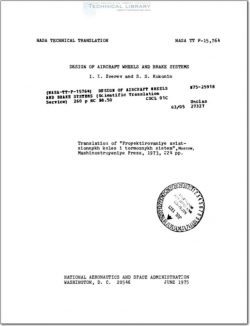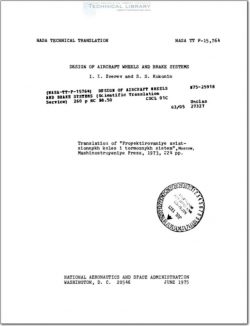NASA-TT-F-15-764

- Version
- 610 Downloads
- 69.29 MB File Size
- 1 File Count
- August 18, 2016 Create Date
- August 18, 2016 Last Updated
Design of Aircraft Wheels and Brake Systems

An attempt is made in this book to summarize the experience in
the design and analysis of aircraft wheels and brakes, brake
systems, brake control systems, and antiskid systems. We examine
some questions of the static and fatitue strength of aircraft
wheels, calculation of brake service life, brake dynamics, techniques
for increasing brake energy absorption capacity, and design of the
basic antiskid system elements. The book is intended 1dr personnel
in the aircraft industry and organizations operating aircraft.
The weight increase and also the increased takeoff and landing £1.
speeds of passenger and cargo aircraft have led to increased
complication of aircraft wheel construction.
The mechanical and thermal loads on the wheels and brake
systems have increased markedly. We need only note that the wheel
brakes of the 11-62 passenger airplane must absorb an energy of
about 18 ' 106 in a single braking after landing which,when
transformed into heat, raises the temperatures of the individual
brake elements to 500° C. The temperature at the friction surface
of the friction elements in this case may reach 1000 -— 1100° C.
Along with the development and perfection of aircraft wheel
construction, the brake control systems have also become more
complicated and advanced. For example, more than 100 different
hydraulic and electrical components are used in the Il—62 braking
system.
Intorduction of an automatic antiskid controller into the brake
control system has been necessary in order to improve braking
effectiveness and reduce tread wear. Special liquid or air cooling
systems are used to reduce brake temperatures, and tire pressure
regulation systems are used to improve wheel flotation on various
soils.
Thus, the range of questions associated with the design of
aircraft wheels and brake systems has broadened considerably.
The basic questions covered in the book include determination
of brake energy absorption capacity, calculation of airplane landing
distance, analysis of the magnitude of the coefficient of traction
of the tire with the airdrome runway surface, and the methods for
thermal and strength analysis of the basic wheel and brake components.
We examine some questions of the design and analysis of the
brake system, antiskid control system, cooling system, tire pressure
regulation system, and also certain questions of the design and
analysis of the components of these systems. The final sections
of the book cover questions associated with wheel and brake testing
and the equipment necessary for these tests.
| File | Action |
|---|---|
| NASA-TT-F-15-764 Design of Aircraft Wheels and Brake Systems.pdf | Download |
Comment On This Post